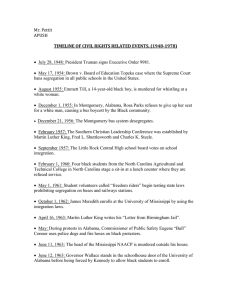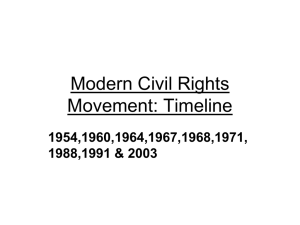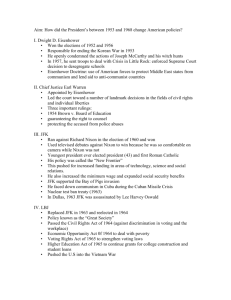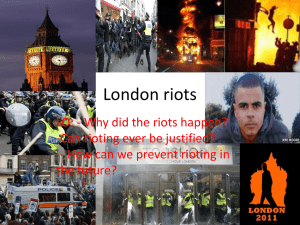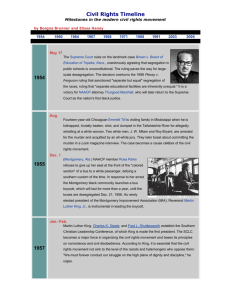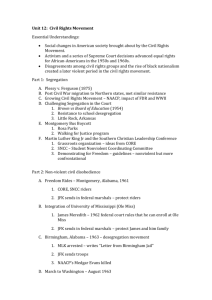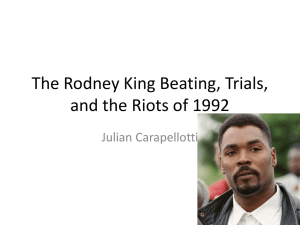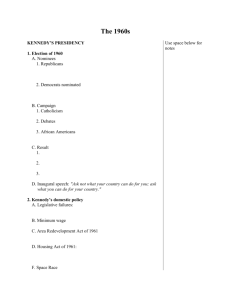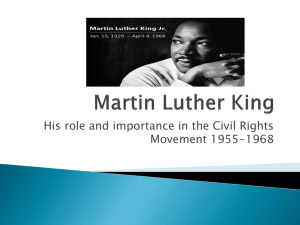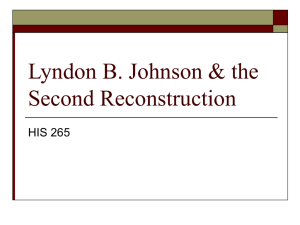The Civil Rights Movement - Manasquan Public School District
advertisement
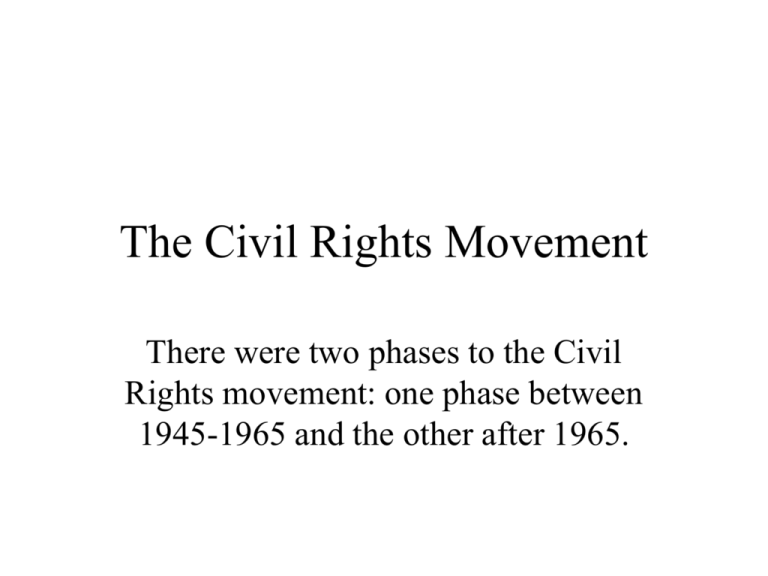
The Civil Rights Movement There were two phases to the Civil Rights movement: one phase between 1945-1965 and the other after 1965. I. Why Did the Civil Rights Movement Take Off After 1945? • Black equality became a significant political issue for the Democratic Party • WWII had been fought against racism abroad— hard to keep harboring it at home • Black veterans came home dedicated to change • Increasing number of White Americans condemned segregation • Discrimination in the United States hurt our propaganda battle against the Communists II. The Truman Years • No significant Civil Rights congressional legislation • Truman moves on his own to do what he can for Civil Rights --Desegregation of the military (1948) • Jackie Robinson’s breakthrough (1947) Plessy vs. Ferguson 1896 • Louisiana Separate Car Act • Supreme court voted 8-1 in support of the Louisiana law. • Weren’t convinced it violated the 13th or 14th amendment. – 13th – Political equality vs. Social equality – 14th – law doesn’t treat African-Americans differently because whites can’t ride on nonwhite cars. • Becomes law of the land until 1954. III. The Battle in the Courts • Plessy v. Ferguson (1896) -- “separate but equal” facilities = legal • Smith v. Allwright (1944) • First attack = “separate is not equal” • Brown v. Board of Education of Topeka, Kansas (1954) -- Chief Justice Earl Warren III. Battle in the Courts (cont.) • Eisenhower disapproves of Brown decision • Desegregation “with all deliberate speed” • Other Warren Court Civil Rights decisions • Popular opposition to the Brown decision • No real progress on desegregation at first IV. The Eisenhower Years • Eisenhower’s philosophy related to Civil Rights laws – Hard to change people. • First Civil Rights Acts passed since the Civil War (1957 (Vote) and 1960) • Opposition to the integration of Little Rock Central High School (1957) National guard --Governor Orville Faubus States rights V. Out of the Schools and Into the Buses • The arrest of Rosa Parks (December, 1955) • The Montgomery, Ala. Bus Boycott • The leadership of Martin Luther King, Jr. • The “Montgomery” model for Civil Rights activism: boycott, publicity, courts • SCLC formed (1957) VI. A Mass Movement Takes Shape • Lunch counter “sit-ins” begin: Greensboro, NC (February, 1960) • SNCC created (April, 1960, John Lewis) • CORE “Freedom Ride” (May, 1961) • Non-violence(Gandhi) • Direct Action VI. A Mass Movement Takes Shape (cont.) • Demonstrations in Birmingham, Alabama (April, 1963) --Eugene “Bull” Connor • “Letter from Birmingham City Jail” • Governor George Wallace tries to block integration of the University of Alabama (Fall, 1963) VI. A Mass Movement Takes Shape (cont.) • JFK finally begins to campaign for Civil Rights legislation • Continued violence even in the face of some progress • Martin Luther King, Jr. and the March on Washington (August, 1963) -- “I Have a Dream” VI. A Mass Movement Takes Shape (cont.) • Mississippi Freedom Summer Project (1964) • MFDP Protests at the 1964 Democratic convention • Voter registration in Selma, Alabama (1965) --Sheriff Jim Clark • By the mid-1960’s, substantial success in the South had been achieved VII. The Kennedy and Johnson Years • JFK’s initial reluctance to push for Civil Rights laws • The integration of Ole’ Miss (1962) --James Meredith • JFK finally decides to push past better enforcement to new congressional Civil Rights legislation VII. The Johnson Years (cont.) • The role of Kennedy’s assassination in the Civil Rights movement • Civil Rights Act of 1964 • Anti-poll tax Amendment (24th—1964) • Voting Rights Act (1965) • Impact of the Voting Rights Act VII. The Johnson Years (cont.) • The tone of public political discourse changed after 1965 • Johnson appoints first Black cabinet secretary: Robert Weaver of HUD (1966) • Much more needed to be done for Civil Rights outside of the South, so 2nd phase began VIII. The Era of Disillusionment: 1965 On • Early to mid-1960’s were a hopeful time for Civil Rights advocates • Goal of Assimilation • A “Spoiled Utopia” after 1965—things would not be that simple A. New Problems • Residential Discrimination -- “Red Lining” • The Challenges of School integration in the North • The historical, traditional segregation of northern cities • The resurrection of the KKK once again • More effective White opponents in the North B. Race Riots • Watts Riots in Los Angeles (Summer, 1965) • Riots each summer from 1965-1969 --Chicago and Cleveland (1966) --Newark and Detroit (1967) --Washington, D.C. (1968) B. Race Riots (cont.) • Riots as an expression of grievance against the White American consumer society • Riots shocked the White American public • Frustration and selfdestruction expressed in these riots • Unlike earlier race riots, these riots were not started by White mobs C. “Black Power” • Growing tension between SNCC and Martin Luther King, Jr. --Stokely Carmichael • “Black Power” • Carmichael succeeded by H. Rap Brown as head of SNCC (1967) C. “Black Power” (cont.) • The formation of the Black Panther Party in Oakland, CA (1966) --Huey Newton --Eldridge Cleaver C. “Black Power” (cont.) • The leadership of Malcolm X --Black Muslims --Assassinated in 1965 • Cultural expressions of “Black Power”: --Afro Hairstyles --Black-studies programs -- “Negro” no longer used --1968 Olympics D. Decline of the Civil Rights Movement • Economic contraction works against Civil Rights concessions • Northern phase not as successful • Resistance from White Unions • Vietnam replaces Civil Rights as the liberal crusade • Martin Luther King, Jr. loses influence with LBJ

